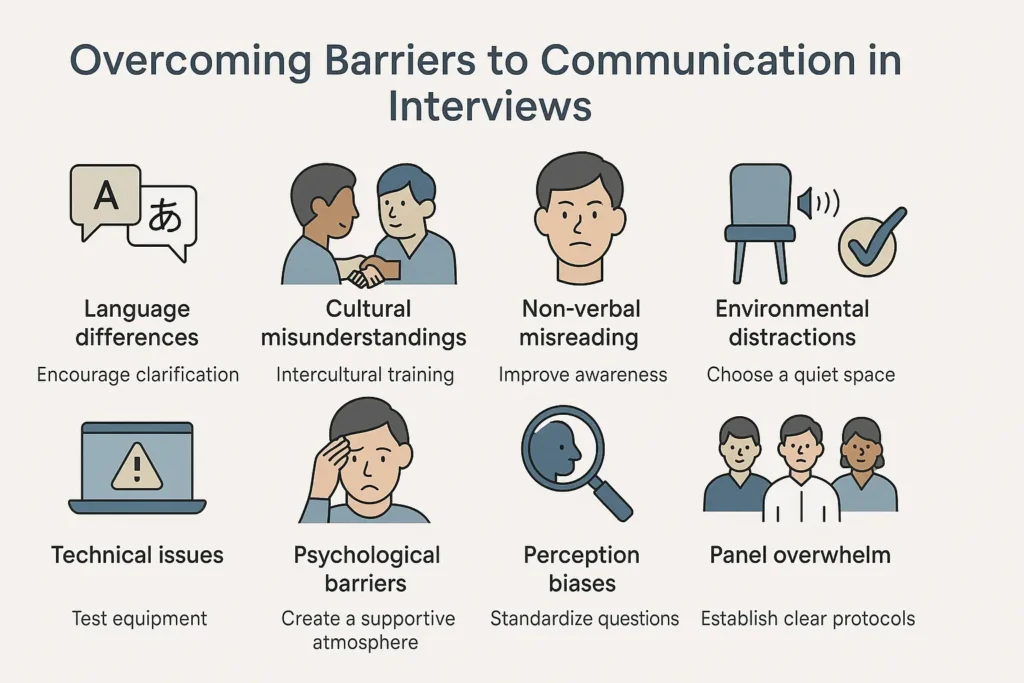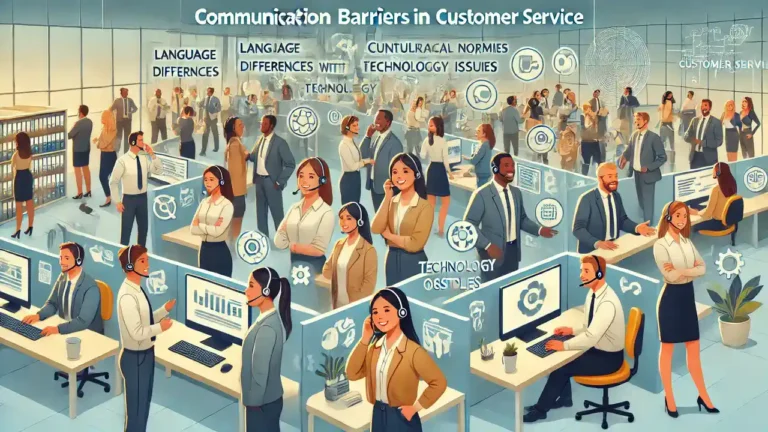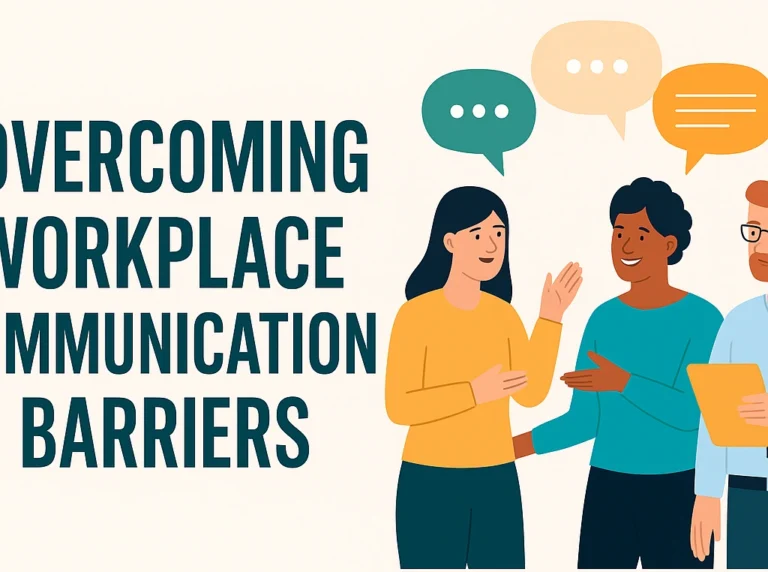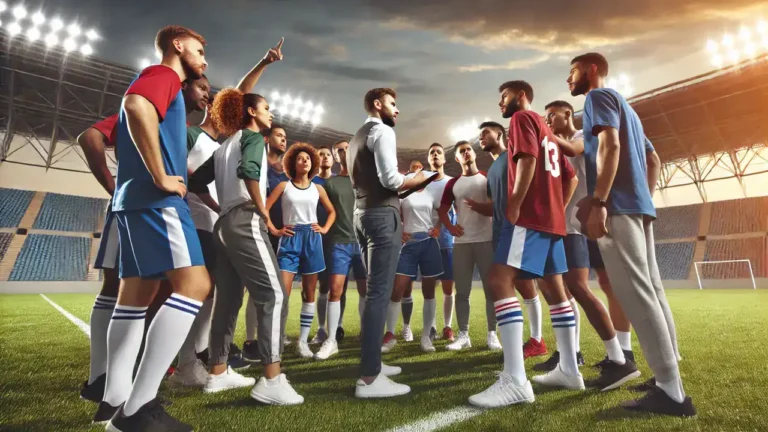Barriers to Communication in Interviews
Interviews are a crucial step in hiring and career development, but what happens when something gets lost in translation? Misunderstandings, stress, and technical hiccups can turn a promising meeting into a missed opportunity. Barriers to communication in interviews are more common than many realize, and they can affect both the candidate and the interviewer.
Whether you’re seeking your first job or hiring for a critical role, learning to spot and solve these barriers is essential for success. In this post, we’ll look at why these barriers happen, what forms they take, and—most importantly—how to overcome them for clearer, more effective conversations.
What Are Communication Barriers in Interviews?
Barriers to communication in interviews refer to anything that disrupts or distorts the exchange of information. This could mean language differences, misread body language, or simply a bad internet connection. The result? Misinterpretation, unfair assessments, or even the loss of a talented candidate.
Interviews can happen in many formats: in-person, phone, video, or panel. Each comes with its own set of potential pitfalls. Understanding these challenges is the first step toward smoother, more productive interviews.
Why Do These Barriers Matter?
When communication breaks down in an interview, the outcome can be costly. A talented applicant may be overlooked, or an organization may bring on someone who isn’t the right fit. For candidates, miscommunication can mean anxiety and missed opportunities. For organizations, it leads to wasted time and resources. That’s why addressing barriers to communication in interviews is vital for everyone involved.
Types of Interview Formats and Their Unique Barriers
Every interview format presents its own challenges for effective communication. Here’s a closer look at how the format itself can become a barrier:
In-Person Interviews
Face-to-face meetings rely on body language, eye contact, and facial expressions. However, these non-verbal cues are often misinterpreted. For example, crossed arms might signal nervousness rather than defensiveness. Some people may read fidgeting as a lack of interest, when it’s really a sign of anxiety.
Phone Interviews
Without the benefit of visual cues, phone interviews can lead to misunderstandings. The tone of voice becomes critical, but even that can be misread. Background noise, unclear audio, or dropped calls can all disrupt the conversation.
Video Interviews
Technical issues are common. Poor internet connectivity, laggy audio, or low-quality video can make it hard to connect. Sometimes, delays in audio lead to awkward pauses or talking over each other. The lack of direct eye contact also reduces trust and engagement.
Panel Interviews
Multiple interviewers can make candidates feel overwhelmed or unsure of where to direct their attention. This can lead to fragmented communication, with different panelists focusing on different aspects.
Tip: Preparation is key. Both interviewers and candidates should know the format in advance, test technology, and agree on clear protocols. LinkedIn Talent Solutions offers practical guides on preparing for each format.
Common Barriers to Communication in Interviews

Language and Cultural Differences
Interviews often bring together people from diverse backgrounds. Accents, idioms, and unfamiliar words can cause confusion. Cultural norms about eye contact, gestures, or how directly to answer a question can also differ. For example, in some cultures, modesty is prized, so a candidate may downplay achievements. In others, directness is expected, which might seem aggressive to someone else.
Key Terms:
- Cultural intelligence: The ability to understand and adapt to different cultural norms.
- Language proficiency: Varying levels of comfort with the interview language.
Solutions:
Encourage clarifying questions. Use simple, clear language. Provide language support if needed. Offer cultural awareness training for interviewers to avoid misinterpretation.
Non-Verbal Communication Challenges
Body language, facial expressions, and tone play a big role in interviews. When these cues are misread, the intended message is lost. Someone’s nervous laughter might be mistaken for lack of seriousness. An interviewer’s flat tone may appear disinterested when they are just focused.
Solutions:
Interviewers should receive training on interpreting non-verbal signals. Candidates can benefit from mock interviews that help build confidence and self-awareness. Alignment of verbal and non-verbal messages creates more authentic exchanges.
Physical and Environmental Distractions
Background noise, poor lighting, and technical interruptions can break concentration. This is especially true for remote interviews, where a barking dog or an unexpected visitor can throw off the flow.
Solutions:
Both parties should choose a quiet, well-lit space and test their equipment before the interview. Provide a checklist for virtual interviews to minimize disruptions.
Psychological and Emotional Barriers
Nervousness, stress, and anxiety can affect performance for both the candidate and the interviewer. Interviewers might be under pressure to fill a position quickly. Candidates may worry about making a good impression, leading to blanking out or giving incomplete answers.
Key Concepts:
- Performance anxiety: The fear of being judged in high-stakes situations.
- Cognitive overload: Too much information, too fast.
Solutions:
Encourage small talk or warm-up questions to break the ice. Practice deep breathing or mindfulness before the interview. Interviewers should project empathy and patience.
Stereotypes, Bias, and Microaggressions
Unconscious bias can affect how responses are judged. Stereotypes based on gender, age, ethnicity, or educational background can lead to unfair evaluations. Microaggressions—subtle, often unintentional comments or actions—may make candidates uncomfortable.
Solutions:
Use structured interviews with standardized questions. Provide interviewer training on unconscious bias and microaggressions. Implement diverse hiring panels and regular bias audits.
Semantic and Language Barriers
Jargon, acronyms, and technical terms can confuse candidates who aren’t familiar with the organization’s lingo. Even within the same language, meanings can shift. A simple term like “deliverables” might mean different things in different fields.
Solutions:
Use plain English and explain technical terms. Check for understanding with open-ended questions. Avoid jargon unless you’re sure the candidate understands.
Technology and Accessibility Barriers
Remote interviews rely on reliable technology. But not everyone has access to high-speed internet, quality cameras, or quiet spaces. Technical glitches can create stress and disrupt the flow.
Key Terms:
- Digital literacy: Comfort with technology and online platforms.
- Accessibility: Making interviews available to people with disabilities.
Overcoming Communication Barriers in Interviews
Preparation and Mock Interviews
Practice is one of the best ways to reduce stress and uncertainty. Mock interviews can help candidates build confidence and help interviewers sharpen their listening and questioning skills.
Solutions:
Use online tools or professional coaching services to simulate interviews. Practice with friends or mentors who can provide constructive feedback.
Active Listening and Clarification
Listening carefully is just as important as asking good questions. Interviewers should paraphrase and summarize candidate responses to ensure they’ve understood correctly. Candidates should feel free to ask for clarification when a question is unclear.
Key Practices:
- Focus fully on the speaker.
- Paraphrase answers (“So, what I’m hearing is…”).
- Ask clarifying questions (“Could you explain that further?”).
Standardized Interview Structure
Consistent questions and scoring rubrics make interviews fairer and help avoid unconscious bias. Structured interviews provide a level playing field for all candidates.
Solutions:
Develop a set of standardized questions. Use clear criteria for scoring answers. Document each interview carefully for comparison.
Accessibility and Inclusion
Ensure that interviews are accessible to everyone, including people with disabilities. This might mean providing closed captions, interpreters, or flexible formats.
Best Practices:
- Use accessible video conferencing platforms.
- Allow extra time for responses.
- Offer alternative formats if requested.
Building Rapport and Empathy
A little empathy goes a long way in creating a supportive interview environment. Greet candidates warmly, use their names, and maintain eye contact (camera lens for virtual). Acknowledge nerves and offer encouragement.
Strategies:
Start with easy questions or ice-breakers. Let candidates know it’s okay to pause and think. Share a bit about the organization’s culture to build trust.
Feedback and Follow-Up
Communication doesn’t end when the interview is over. Timely and transparent follow-up leaves a positive impression and supports a fair process.
Tips:
- Send status updates as soon as possible.
- Offer constructive feedback, especially to finalists.
- Allow candidates to ask questions about the process.
Questions to Show Communication Barriers in an Interview
Here’s a list of interview questions you can ask to identify if a candidate struggles with communication barriers.
These are grouped by barrier type so you can detect verbal, nonverbal, cultural, and psychological obstacles.
1. General Communication Skills
- Can you describe a time when you had to explain a complex idea to someone unfamiliar with the topic? How did you make sure they understood?
- Tell me about a situation where your message was misunderstood. What happened, and how did you handle it?
- When you give instructions, how do you confirm that others have understood them correctly?
2. Verbal Communication Barriers
- Have you ever been in a meeting where people kept talking over each other? How did you handle it?
- Give an example of when you received unclear instructions. What did you do next?
- How do you adjust your communication style when speaking to someone with less technical knowledge?
3. Nonverbal Communication Barriers
- Describe a time when nonverbal cues (body language, facial expressions) caused confusion in a conversation.
- Have you ever misread someone’s tone or expression? How did you resolve the misunderstanding?
- How do you ensure your nonverbal signals match your spoken message?
4. Cultural Communication Barriers
- Have you worked with people from different cultural backgrounds? How did you handle differences in communication styles?
- Give an example of when cultural differences caused confusion. How did you overcome it?
- What steps do you take to avoid misinterpretations when working with people whose first language isn’t the same as yours?
5. Psychological Communication Barriers
- Describe a time when stress or emotions affected how you communicated.
- How do you handle situations where you feel nervous or anxious during important discussions?
- Have you ever noticed that someone was distracted or emotionally disengaged during a conversation? What did you do?
6. Listening & Feedback
- How do you show someone you are actively listening?
- Have you ever received critical feedback that was hard to accept? How did you respond?
- Can you recall a situation where misunderstanding happened because you didn’t ask enough questions?
Conclusion
Barriers to communication in interviews can stop both candidates and organizations from seeing the full picture. From language differences to technical problems, each obstacle can be addressed with awareness, preparation, and empathy. Whether you’re preparing for your next interview or building a hiring process, take the time to reduce these barriers. Not only does it help you find the best talent, but it also creates a fairer, more inclusive experience for everyone.






